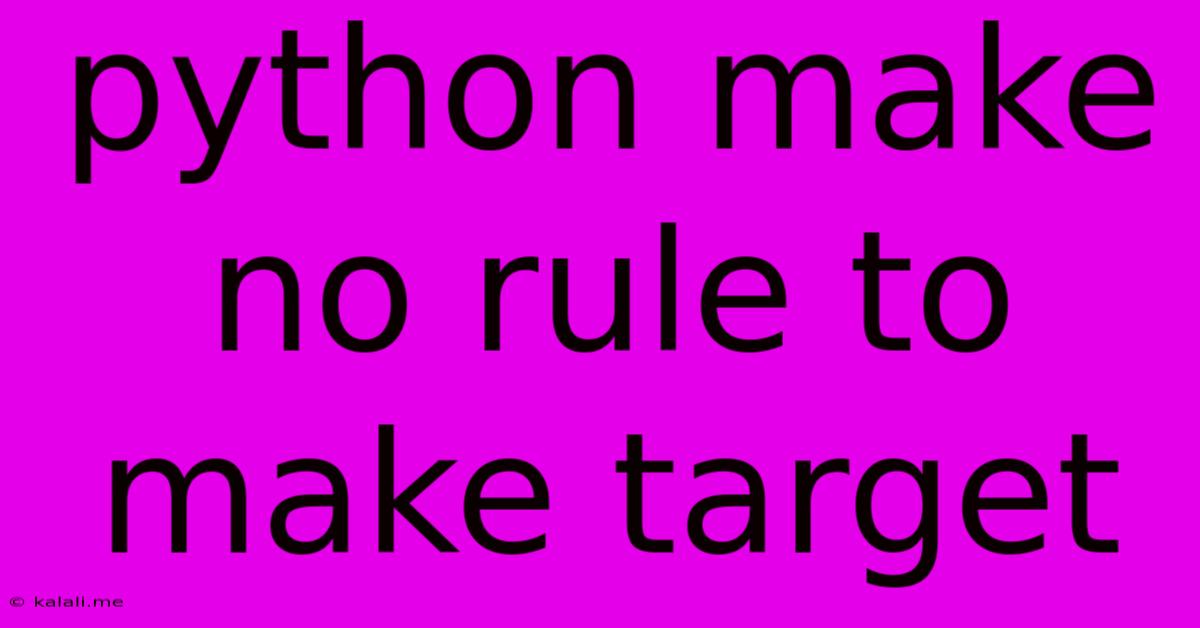Python Make No Rule To Make Target
Kalali
Jun 06, 2025 · 3 min read

Table of Contents
Python's Make: No Rules, No Problem – Building Your Projects Efficiently
Meta Description: Learn how to leverage Python's flexibility to build projects without explicitly defining rules in make, streamlining your workflow and simplifying your build process. This guide explores alternative approaches for managing dependencies and automating tasks.
Building software often involves managing dependencies and automating repetitive tasks. Tools like make are traditionally used for this, relying on explicit rules to define how targets are built. But Python, with its dynamic nature and rich ecosystem of libraries, offers alternative approaches that can be simpler and more efficient for many projects. This article explores how to effectively manage your Python projects without resorting to the intricacies of writing make rules.
Why Avoid Explicit make Rules in Python Projects?
While make is powerful for complex projects with intricate build processes, its rule-based system can become cumbersome for simpler Python projects. The overhead of defining dependencies and commands can outweigh the benefits, especially when Python's own capabilities can handle much of the automation.
Here are some reasons why you might choose to forgo make rules in your Python projects:
- Simplicity: Python's built-in functionality and package management tools often suffice for smaller projects, reducing complexity.
- Readability:
makefiles can become difficult to read and maintain, especially for larger projects. Python scripts, on the other hand, offer greater readability and maintainability. - Flexibility: Python allows for more dynamic and flexible build processes compared to the rigid structure of
makerules.
Alternative Approaches for Building Python Projects Without make
Several strategies effectively manage Python projects without needing explicit make rules:
1. Leveraging pip and virtualenv:
For managing dependencies and creating isolated environments, pip and virtualenv are the cornerstones of Python development. pip handles installing and managing packages from PyPI, while virtualenv creates isolated environments to prevent dependency conflicts between different projects. This combination eliminates the need for make to handle dependency management.
python3 -m venv .venv
source .venv/bin/activate
pip install -r requirements.txt
This simple sequence manages dependencies effectively without writing a single make rule.
2. Utilizing setuptools and invoke:
For more complex projects requiring custom build steps, setuptools and invoke provide powerful alternatives to make. setuptools handles packaging and distribution, while invoke offers a task runner similar to make, but with a cleaner, Pythonic syntax.
# tasks.py (invoke file)
from invoke import task
@task
def build(c):
c.run("python setup.py build")
@task
def test(c):
c.run("pytest")
You can then run these tasks directly from your terminal: inv build or inv test.
3. Scripting with Python:
For highly customized build processes, a Python script can be the most flexible and powerful solution. You can leverage Python's capabilities to create intricate build logic, manage dependencies, run tests, and perform other tasks, all within a readable and maintainable Python script. This provides far greater control and flexibility than make.
# build.py
import subprocess
def build_project():
subprocess.run(["python", "setup.py", "build"])
# ... other build steps ...
if __name__ == "__main__":
build_project()
This approach offers maximum flexibility, allowing for highly tailored build processes.
Conclusion: Choosing the Right Approach
The best approach to building your Python projects without make depends on your project's complexity and your preferences. For small projects, pip and virtualenv are usually sufficient. For medium-sized projects, setuptools and invoke provide a good balance between simplicity and power. For large and complex projects with highly customized build processes, a dedicated Python script offers the ultimate flexibility. By carefully selecting the appropriate tools and techniques, you can streamline your Python development workflow and focus on what matters most: building great software.
Latest Posts
Latest Posts
-
Why Couldnt Moses Enter The Promised Land
Jun 07, 2025
-
Why Does Nasdaq Not Publish Order Book Anymore
Jun 07, 2025
-
What Is A Naturalized Or Derived Citizen
Jun 07, 2025
-
Where Can I Watch Boku No Pico
Jun 07, 2025
-
How Thick Should Concrete Be For A Driveway
Jun 07, 2025
Related Post
Thank you for visiting our website which covers about Python Make No Rule To Make Target . We hope the information provided has been useful to you. Feel free to contact us if you have any questions or need further assistance. See you next time and don't miss to bookmark.